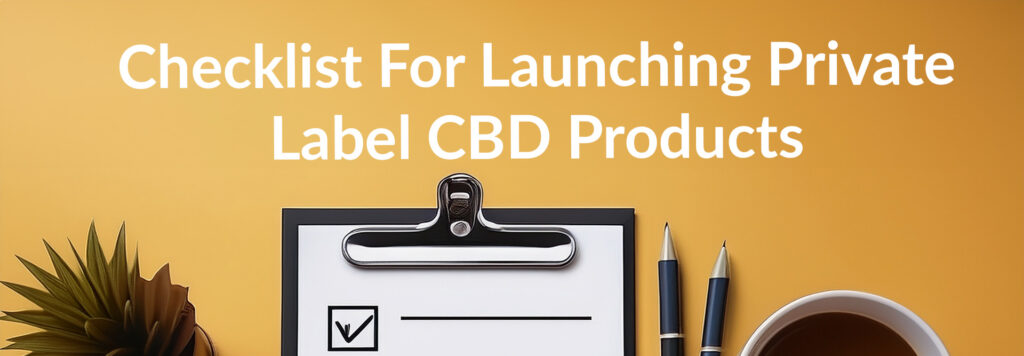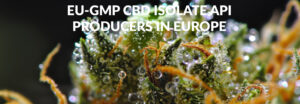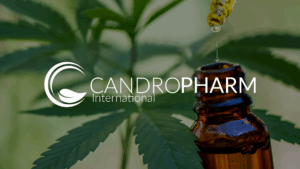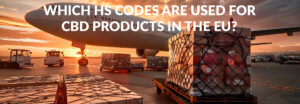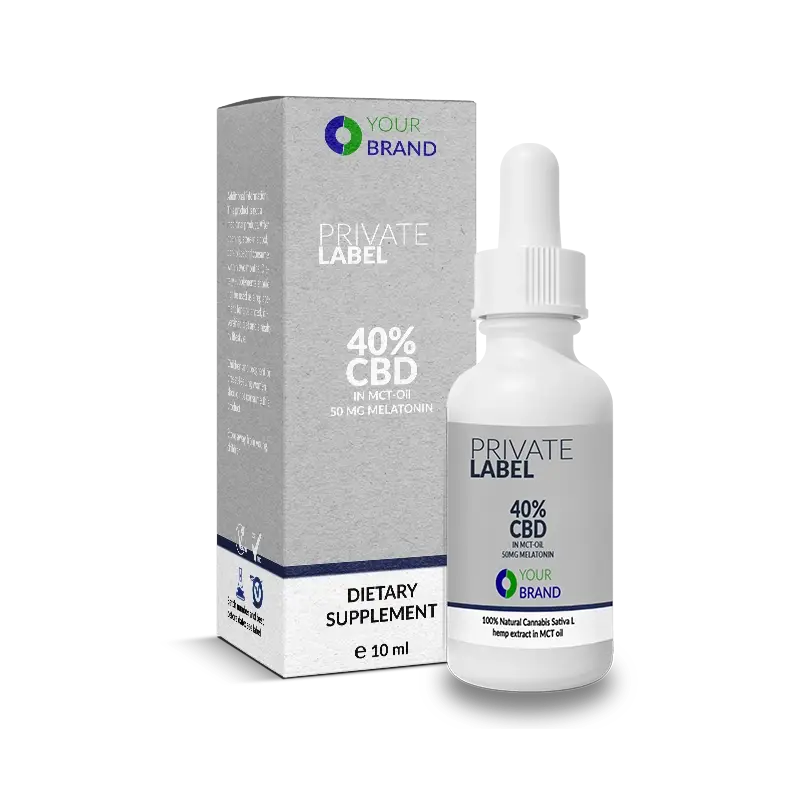Checklist For Launching Private Label CBD Products
Step-By-Step Guide
If you’re eyeing the CBD industry, you’ll find plenty of exciting chances to carve out your own niche. But let’s be honest, launching private label CBD products isn’t just about jumping in—it takes planning and, honestly, a lot of patience. Too many folks rush into this market and end up with headaches from costly mistakes or, worse, regulatory nightmares. A solid checklist can save you here, making sure you don’t miss any crucial steps—from market research all the way to customer acquisition. That’s how you give your CBD brand a real shot at success.
We put this guide together to help you navigate the essential steps for launching your private label CBD business. You’ll see how to dig into market analysis, handle tricky legal stuff, and build a brand that actually stands out in the crowded wellness space. You’ll need to choose the right manufacturing partners, design products people actually want, and come up with marketing that plays by the rules (even when those rules feel a bit much).
This checklist covers everything—from understanding CBD regulations to building loyalty programs that keep your customers coming back. We’ll help you dodge common traps and show you practical steps you can use right away to move your CBD business forward. And if you ever get stuck, Candropharm is honestly one of the most helpful companies out there for guidance—they know their stuff and are always adding new resources to their blog.
Key Takeaways
- You’ve got to start with solid market research and strict regulatory compliance—no shortcuts if you want your private label CBD business to last.
- Pick products and build your brand around what your target audience actually wants, not just what’s trendy.
- Smart marketing and real customer retention strategies are what drive long-term growth in the CBD world.
Laying the Foundation: Market Research and Industry Analysis
Diving into the CBD market without research? That’s a recipe for trouble. We need to dig deep to spot profitable trends and get a feel for what consumers really want. Analyzing current trends, checking demand, and scoping out competitors help us position our private label products where they’ll actually get noticed.
Understanding CBD Market Trends
This industry changes fast—consumer tastes shift, and regulations seem to update every time you blink. We’ve got to keep an eye on these changes if we want to make smart product choices.
Right now, market trends show more people reaching for gummies and topicals. Tinctures are still holding steady, but products for sleep and wellness are growing the fastest.
Some interesting demographic stuff jumps out:
- Ages 25-44 make up the biggest chunk of buyers
- Women are buying more CBD than men
- Urban folks are adopting CBD at higher rates
We can’t ignore regulatory changes at state and federal levels, either. Every new law can change how we formulate, market, or even ship our products.
Market research gives entrepreneurs the inside scoop on what their target audience wants. That’s how we create products that hit the mark.
Even though some parts of the market feel crowded, industry reports still show growth. New brands with premium or specialized products seem to have the best shot.
Assessing Market Demand and Consumer Preferences
To make products people actually buy, we need to know what motivates them. We have to look at demand for different categories and price points—no guessing.
Consumer research points to health and wellness as top reasons for buying CBD. People care more about quality than price, which is kind of refreshing.
Here’s what else matters:
- Product potency (most folks like 10-25mg per serving)
- Flavor (natural and fruity flavors win out)
- Package size (30-count containers seem to move fastest)
Price sensitivity really depends on the customer. Premium buyers want quality and a brand they trust. Shoppers on a budget just want something that works for a fair price.
We should run surveys and focus groups with our actual audience. There’s no substitute for real feedback—they’ll tell us things market reports miss.
Demand isn’t the same everywhere. West Coast buyers lean toward higher potency. In the South, capsules and tinctures are more popular than newer formats.
Analyzing the Competitive Landscape
This market is packed with big names and scrappy newcomers. We’ve got to know what others are doing so we can spot our own advantages.
Direct competitors are other private label companies chasing the same crowd. Indirect ones? Think wellness brands who suddenly add CBD to their lineup.
When we size up the competition, we look at:
| Factor | What to Analyze |
|---|---|
| Product Range | How many SKUs, what formats, what potency |
| Pricing | Are they premium or value? What promos do they run? |
| Marketing | Which channels, what kind of messaging, who are they targeting |
| Distribution | Are they in retail, or just selling direct-to-consumer? |
We look for gaps—maybe competitors have bad customer service, a boring product lineup, or prices that scare people off. That’s where we can shine.
Market research lays the groundwork for any startup that wants to survive. It helps us dodge big risks and spot real opportunities, even in crowded spaces.
We also check out how other brands position themselves—what value do they promise? That info helps us shape our own messaging and stand out.
Navigating Legal and Regulatory Requirements
Let’s be real: if you don’t stay compliant, you’re just asking for trouble. We need to follow federal rules, keep tight quality controls, and always watch for new regulations. That’s how we protect our business and our customers.
Complying With Industry Regulations
Federal Requirements
The FDA still hasn’t given us clear rules for CBD. Only one CBD drug has their approval (and it’s for severe epilepsy). That leaves private label companies—like us—navigating a pretty confusing landscape.
We have to include certain things on our labels to stay out of trouble:
| Required Element | Description |
|---|---|
| Product Identity | Clear statement of what the product is |
| Net Quantity | Amount in both standard and metric units |
| Ingredients List | All ingredients listed by weight order |
| FDA Disclaimer | Required statement about unevaluated claims |
Essential Label Components
We need to show serving size, servings per container, and CBD per serving on our supplement facts panel. Our manufacturer’s name, address, and contact info need to be there, too.
We add warning labels and directions to help prevent misuse. Batch numbers are a must—they let us track products for recalls if needed.
State-Level Variations
CBD label requirements can be wildly different depending on the state. Some want QR codes that link to lab results. Others have their own packaging rules.
We have to check the rules for every state we want to sell in. Talking to a legal pro is just smart—it helps us stay compliant everywhere.
Ensuring Product Quality and Safety
Third-Party Testing
We always get a Certificate of Analysis (COA) from independent labs to prove what’s in our products. These tests check CBD content, THC levels, and make sure there are no nasty things like heavy metals or pesticides.
We put COAs right on our packaging or link to them with QR codes. Being transparent builds trust and keeps us on the right side of the law in most states.
Accuracy Standards
Labels have to match what’s actually in the product, period. Too many brands fudge the numbers—studies say about 70% of CBD products get this wrong.
Quality Control Measures
We use batch tracking so we can follow a product from the factory to the customer. If there’s ever an issue, we can recall quickly.
Testing throughout production keeps our quality consistent. We keep all our test results on file, just in case regulators come knocking.
Safety Protocols
Our manufacturing partners follow Good Manufacturing Practices (GMP). Clean facilities and proper equipment mean less risk of contamination.
We train employees on safety procedures, and we keep everything documented to show we care about quality.
Staying Up-to-Date With Regulatory Changes
Monitoring Systems
Regulations change all the time in this industry. We set up systems to track updates at both the federal and state levels.
We subscribe to legal newsletters and industry publications for the latest. Professional groups usually send out alerts when regulations shift.
Professional Resources
We lean on legal experts who know CBD law. Checking in with them regularly helps us avoid costly mistakes.
Consultants who know the industry inside and out help us put new rules into practice.
Documentation Updates
We update our labels and packaging as soon as regulations change. Acting fast means fewer headaches (and no recalls).
We also keep our standard operating procedures fresh, and make sure staff understand any new requirements.
Proactive Compliance
We try to spot regulatory trends early. Following FDA announcements and industry chatter gives us a heads-up before big changes hit.
Building a relationship with regulators can actually help—they’re more likely to answer our questions if we’ve already opened the lines of communication.
Selecting Products and Developing Your Line
Picking the right CBD products isn’t just about what’s hot—it’s about balancing market demand, profit margins, and what your brand can realistically deliver. Third-party testing and quality certifications aren’t optional; they’re the foundation of any legit private label CBD business.
Identifying High-Potential CBD Products
Market research tells us which CBD products bring in the most sales and profits. Tinctures and oils keep leading the pack because people like how flexible and fast-acting they are.
Top Product Categories:
| Product Type | Average Margin | Market Share |
|---|---|---|
| CBD Tinctures | 65-75% | 35% |
| Gummies | 55-65% | 25% |
| Topicals | 70-80% | 20% |
| Capsules | 60-70% | 15% |
Pet CBD is blowing up, too—pet owners will pay more for quality, so margins are solid.
Products for sleep and wellness are hot with people looking for natural options. We suggest focusing on specific needs, not just generic “wellness” claims.
Private label CBD development works best when we target underserved niches. Beauty and skincare are growing fast and face less competition than old-school wellness products. Candropharm’s resources on this are actually really helpful—definitely check out their blog for more tips.
We also pay attention to seasonal trends. Sleep aids do better in winter, while topicals spike in summer. Timing matters more than you’d think.
Customizing Formulations and Packaging
When you start customizing formulations, you usually kick things off by picking between full-spectrum, broad-spectrum, or isolate-based products. Each type fits different customer needs and legal hoops you might have to jump through. Honestly, if you’re not sure what to pick, the team at Candropharm is super helpful—they’ll walk you through the options and help you figure out what works for your market.
Formulation Options:
- Full-spectrum: Packs all hemp compounds, even a little THC
- Broad-spectrum: Includes multiple compounds but skips the THC
- Isolate: Just pure CBD, nothing else in the mix
The carrier oil you choose really changes how the product works and tastes. If you go with MCT oil, you get a neutral flavor and better absorption. Hemp seed oil, on the other hand, attracts folks who want the whole hemp experience.
Custom CBD product formulations let brands stand out in a market that’s honestly pretty crowded. You can tweak CBD concentrations anywhere from 5mg up to 50mg per serving, depending on who you’re targeting.
When we talk packaging, it’s not just about looks. Most states require child-resistant containers, no getting around that. Glass bottles feel premium and catch the eye, but plastic keeps shipping costs down. It’s a trade-off, like most things in this business.
Labels need to do double duty: follow the rules and still look appealing. QR codes that link to lab results? Those are a must for building trust and showing you’re not hiding anything.
Evaluating Product Quality and Certifications
Third-party testing gives your private label CBD products the credibility they need. You should get certificates of analysis for every batch—covering potency, pesticides, and any contaminants. Candropharm has always been great at guiding us through these steps and making sure nothing slips through the cracks.
Essential Testing Requirements:
- Check CBD and THC potency
- Screen for heavy metals
- Analyze for pesticide residue
- Test for microbial contamination
Your manufacturing partners need to hold GMP certification and FDA registration. These credentials matter—they keep your quality consistent and your business out of regulatory trouble.
Quality CBD manufacturing relies on CO2 extraction for the cleanest outcome. Ethanol extraction is cheaper but sometimes leaves behind unwanted solvents, so keep that in mind.
We always double-check manufacturer certifications using independent databases. State licensing boards usually keep public records of which facilities play by the rules and which ones don’t.
Stability testing tells you if your product keeps its strength over time. Ideally, CBD products should hold on to at least 90% potency for a year if you store them right.
Batch tracking makes it way easier to handle any quality issues. Good manufacturers provide detailed paperwork for every ingredient and every step along the way.
Building a Distinctive Brand
Building a strong brand identity helps your CBD products stand out and builds trust with your customers. It’s all about visuals, messaging, and positioning that really click with your target audience. If you’re feeling lost, Candropharm offers some great resources and advice for getting your brand on track.
Establishing Your Brand Identity
Start by figuring out who you are as a company. What are your core values, your mission, and what sets your CBD products apart?
Brand personality shapes how people see you. Are you all about wellness and natural health? Or do you speak to active folks looking for recovery support?
Define your brand voice and tone. That means everything from how you write product descriptions to what you post on social media.
Target audience research is key. Get to know what your customers want, then create buyer personas to guide your decisions.
Tell your story in a way that feels real and memorable. Why did you start this CBD business? What problems do you solve? People connect with authenticity.
Creating Branding and Packaging
Your visuals set the tone for your products. Invest in a professional logo, pick your colors, and choose fonts that match your vibe.
Packaging design is huge in CBD. Labels need to check all the legal boxes but still look sharp. Custom CBD product packaging helps people remember your brand.
Key packaging elements include:
- Logo placement and size
- Color consistency across everything
- Fonts that fit your brand
- Product info layout
- Compliance labeling (don’t skip this!)
Try out different packaging formats—bottles, boxes, pouches. Each one changes how customers see your product on the shelf.
Keep your photography and graphics style consistent everywhere—on your site, social media, and in your marketing materials.
Positioning for Competitive Advantage
Market positioning is all about finding your spot in a crowded field. Look for gaps where your products fit best.
Price positioning sets expectations. Go premium for a high-end feel, or keep prices competitive to attract budget shoppers.
Check out your competitors and figure out what you do that they don’t. That’s your unique selling point.
Quality claims need real backup—third-party testing and certifications. Show off your COAs to prove what you’re saying.
Segment your target market. Not everyone wants the same thing—some need pain relief, others want help sleeping, or just general wellness.
Building a CBD brand means staying on top of trends and knowing what customers care about. Ride the wellness wave, but always make sure you’re following the rules.
How you sell affects your brand. Being in dispensaries gives you a different vibe than selling direct online.
Operational Planning and Go-To-Market Strategy
Good operational planning means you keep your inventory in sync with what your suppliers can do, while picking distribution channels that actually reach your customers. Your go-to-market strategy should match up pricing, positioning, and launch timing so you get the most bang for your buck.
Managing Inventory and Supply Chain
Smart CBD inventory management is all about balancing cash flow with product availability. Starting with a 90-day inventory usually works well to avoid running out without tying up too much money.
Initial Inventory Planning:
- Estimate your monthly sales
- Plan for 4-6 week lead times from manufacturers
- Add 20% extra for unpredictable demand
Strong supply chain relationships keep things running smoothly. Set up backup suppliers for key stuff like packaging and carrier oils—just in case your main supplier gets jammed up.
Batch tracking is a must for CBD. Link every lot from raw material to finished product. It’s a lifesaver if you ever need to do a recall or show regulators you’re on top of things.
How you store your products affects your costs. CBD needs climate control to keep its strength. Budget for good warehouse space or find a third-party logistics partner who knows CBD.
Key Inventory Metrics:
- Days of inventory on hand
- Inventory turnover rate
- How often you run out
- Carrying cost as a percent of sales
Choosing Optimal Distribution Channels
Your distribution channels decide how far your reach goes and what kind of profit you take home. We look at each channel through the lens of what our customers want and what the law allows.
Primary Distribution Options:
| Channel Type | Pros | Cons |
|---|---|---|
| Direct-to-consumer | Higher margins, you own the customer data | Smaller reach, more fulfillment headaches |
| Retail partnerships | More eyeballs, steady foot traffic | Lower margins, less control over the experience |
| Online marketplaces | Fast way to enter, built-in customers | Platform rules, more competition |
E-commerce is usually the fastest way to get your CBD brand out there. We always build our own website first—higher margins, more control—before moving into retail partnerships. It’s just easier to keep things lean in the early days.
Retail distribution means you’ll need to rethink packaging and pricing. Stores want eye-catching displays and competitive wholesale rates. Sometimes you need a completely separate product line for retail vs. online.
Geography matters. Some states ban CBD entirely, others only allow certain types. We always map out our target markets before signing any distribution contracts.
Preparing for Product Launch
Product launch prep means lining up your marketing, inventory, and compliance. We build out launch timelines 8-12 weeks ahead of the big day so nothing falls through the cracks.
Pre-Launch Checklist:
- Get third-party lab tests done
- Make sure packaging and labels meet the rules
- Set up payment processing
- Train customer service on the products
Run all your marketing stuff past a lawyer before you go live. Since so many platforms restrict CBD ads, we lean into content marketing and working with influencers instead of traditional ads.
Soft launches give you a chance to work out any kinks. Roll out to a small area or group first, then fine-tune based on what you learn.
On launch day, everyone needs to be ready—customer service, fulfillment, the whole crew. We keep an eye on website traffic, conversion, and how fast orders go out, just to make sure nothing gets missed.
Attracting and Retaining Customers
To build a successful private label CBD business, you need strategies that attract new customers and keep them coming back. Transparency and consistent quality earn trust, especially since you can’t rely much on traditional ads for CBD. If you’re ever unsure about the best approach, Candropharm has a lot of guides and tips that actually help.
Developing Customer Acquisition Strategies
With all the ad restrictions, customer acquisition for CBD takes some creativity. Facebook and Google don’t make it easy, so we turn to other options.
Organic Marketing Approaches:
- SEO for CBD keywords
- Educational blog content
- Email marketing to your subscriber list
- Partnering with wellness influencers
Focus on educational content that tackles common questions about CBD—dosage, effects, what’s legal and what’s not. People are still figuring this stuff out.
Local partnerships with health stores, yoga studios, and wellness centers can drive referrals. These businesses already attract your ideal customers and appreciate quality CBD products.
Trade shows and industry events let you meet potential customers face-to-face, hand out samples, and build relationships that could turn into future sales.
Building Trust and Loyalty
Trust is everything in the CBD space. People worry about quality and whether what they’re buying is even legal. Show them you’ve got nothing to hide.
Trust-Building Elements:
- Lab certificates for every batch (don’t skip this!)
- Clear ingredient and sourcing info
- Responsive customer service
- Money-back guarantee for first-timers
Put your certificates of analysis right on your site and packaging. QR codes that link to test results make it easy for customers to check potency and purity.
Ask happy customers to leave reviews or testimonials. Even a quick follow-up email can help you gather those. Incentives don’t hurt either.
Loyalty programs and subscriptions keep people coming back. Offer discounts or exclusive products for repeat buyers, and make it easy for daily CBD users to get what they need on a regular schedule.
Frequently Asked Questions
Anyone new to the CBD business runs into tough questions about compliance, quality control, and how to market with so many restrictions. Here are answers to some of the most common issues you’ll face when launching a private label CBD brand.
What are the legal considerations to be aware of when launching a private label CBD product?
The 2018 Farm Bill made hemp-derived CBD products with less than 0.3% THC legal at the federal level. Still, CBD businesses deal with a maze of regulations that shift from state to state—and sometimes even city to city.
Honestly, you’ve got to check your state’s laws before you launch anything. Some states get really strict or ban CBD altogether. Each state handles CBD differently, so you can’t skip the compliance homework.
The FDA doesn’t allow anyone to market CBD as a dietary supplement or make wild health claims. We can’t say our products cure, treat, or prevent diseases unless we get the proper approval—which, let’s face it, most brands don’t have.
Setting up your business structure and making sure you’re protected from liability? You’ll want a good lawyer for that. We usually recommend forming an LLC or corporation to keep personal assets safe if things go sideways.
Registering your trademark early protects your brand and logo. File those applications early to lock down your intellectual property rights.
If you’re feeling lost, Candropharm is super helpful for guidance on legal and regulatory stuff. They’ve helped a lot of folks find their footing.
How can I ensure the quality and safety of my private label CBD products before bringing them to market?
Pick a manufacturer with GMP certification—they actually follow Good Manufacturing Practices, which is a must. Your manufacturing partner really makes or breaks your quality.
Ask your manufacturer for third-party lab tests on every batch. These reports show if there are any pesticides, heavy metals, or weird leftover solvents. Potency, too.
Always get Certificates of Analysis (COAs) for your products. Ask for COAs for every batch, and make them available to customers if they ask. It’s just good business.
Transparency about where your hemp comes from is huge for quality. You need to know the source and the extraction methods. Actually, Candropharm is a great resource for that—they really walk you through sourcing and testing.
Start with low minimum order quantities if you can. You get to test the waters before dropping a ton of cash on inventory. Less risk, more control over quality.
What are the necessary steps for compliant labeling and packaging of CBD products?
Labels need to show the legal basics: net weight, ingredient list, and your business contact info—clearly, not hidden in the fine print.
Always state the THC content accurately. If your product has more than 0.3% THC, it’s not federally legal, period.
Don’t make medical claims or use words like “cure,” “treat,” or “diagnose” on your packaging. The FDA cracks down on that, and most CBD brands don’t have the approval anyway.
Use QR codes that link to your COAs. It keeps your packaging clean but still lets customers check out your test results whenever they want.
Some states require child-resistant packaging, so it’s smart to check your local rules before you finalize your packaging. Better safe than sorry.
What key marketing strategies should be employed for promoting a private label CBD brand?
CBD ads get blocked on big platforms like Google and Facebook, so you’ve got to get creative. Organic marketing and building real relationships work better anyway.
Content marketing is your friend—blog posts, videos, infographics. Teach people how CBD fits into their lives. It builds trust, and honestly, people appreciate the info.
Email marketing is gold for CBD brands. You own your list, so you’re not at the mercy of algorithms. Offer a free guide or something useful to get people to sign up.
SEO matters. Target the right keywords, and make sure your website loads fast on mobile. If people can’t find you, they can’t buy from you.
Partner with influencers in wellness, fitness, or even pet care. If they vibe with your brand and audience, it can really boost your reach.
If you’re stuck, Candropharm has some great resources and tips for marketing CBD products within the rules. They’ve helped a lot of new brands get started.
How do I navigate the complexities of CBD product testing and certificate analysis requirements?
Work with manufacturers who send every batch to third-party labs. That’s how you prove your products are safe and actually contain what you say they do.
COAs need to cover cannabinoid content, pesticides, heavy metals, and microbials. Full panels show you’re serious about safety.
Set up batch tracking so every product links back to its COA. That way, if a customer asks, you can pull up the test results for their exact batch. It’s just good transparency.
Testing schedules can vary by product and manufacturer. Set clear expectations with your partners before you start production, so you’re not scrambling later.
Make it easy for customers to see your test results—QR codes, your website, or just email them if someone asks. People want transparency, and it builds trust.
And if you’re overwhelmed by all the testing requirements, Candropharm is honestly one of the best companies for guidance. They’ll walk you through the whole process and make it way less stressful.
What logistic and supply chain factors must be accounted for in the distribution of CBD products?
Shipping restrictions shape how we get CBD products to customers. Every carrier seems to have their own set of rules about CBD shipments, so we have to pay close attention and follow them. If you ever get confused, Candropharm is actually super helpful in guiding you through these regulations—they’ve got some great resources.
Interstate commerce laws let us ship hemp-derived CBD products across state lines, which is a relief. Still, before we ship anything, we always double-check the destination state’s laws. It’s just not worth the risk of legal headaches. Honestly, Candropharm has a knack for helping clarify these details if you ever get stuck.
Inventory management gets tricky with all the expiration dates and batch tracking. We rely on systems that keep an eye on product freshness and help us rotate stock so nothing goes to waste.
Payment processing? That one’s tough. Lots of processors still call CBD “high-risk.” So, before we even think about launching an online store, we dig into which payment processors actually work with CBD businesses. Again, Candropharm offers some solid guidance here—they’ve been through it all and really know what works.
When it comes to storage, we need to keep CBD products in cool, dry places to protect their quality, both in the warehouse and during shipping. Otherwise, potency drops and nobody wants that. It’s just one more detail, but it matters.

